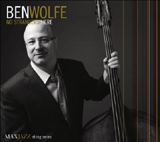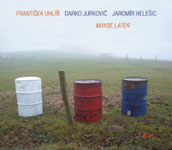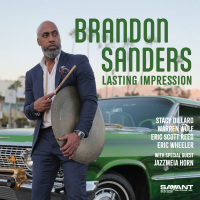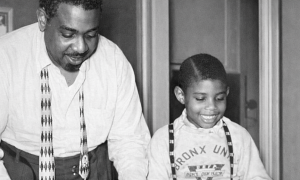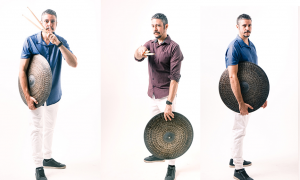Home » Jazz Articles » Interview » Django Bates: Spring Is Here (A Long Time Coming But Wor...
Django Bates: Spring Is Here (A Long Time Coming But Worth The Wait)
With all my delicate detail, I wanted someone to come in and go 'yeah!' and crank it up, smash it out of the speakers.
 July, 2008: It's been 13 years since British composer and keyboards/peck horn player Django Bates released the third album in his "four seasons" series, Winter Truce (And Homes Blaze) (Winter & Winter, 1995). That album followed close behind Autumn Fire (And Green Shoots) (Winter & Winter, 1994) and Summer Fruits (And Unrest) (Winter & Winter, 1993).
July, 2008: It's been 13 years since British composer and keyboards/peck horn player Django Bates released the third album in his "four seasons" series, Winter Truce (And Homes Blaze) (Winter & Winter, 1995). That album followed close behind Autumn Fire (And Green Shoots) (Winter & Winter, 1994) and Summer Fruits (And Unrest) (Winter & Winter, 1993).It has long been Bates's intention to complete the series with a spring-themed album, and in June, 2008 he finally did so with Spring Is Here (Shall We Dance?) (Lost Marble, 2008). It's made with the 19-piece StoRMChaser, the post-graduate big band at Denmark's Rhythmic Music Conservatory (RMC), where Bates was appointed Professor of Rhythmic Music in 2005. A rich and riotous recalibration of orchestral jazz, in the tradition of Bates's work with Loose Tubes in the 1980s and Delightful Precipice in the 1990s, it's a defining masterpiece in his already distinguished big band discography.
Following the demise of original releasing label JMT, the first three albums in the four seasons series became hard to obtain, but are now available again on Winter & Winter. Not so, sadly, the three discs Bates made with Loose Tubes, of which in particular the first two—Loose Tubes (Loose Tubes, 1985) and Delightful Precipice (Loose Tubes, 1986)—are worth scouring used vinyl bins and internet auction sites for from here to Saturn and back on the off-chance you might get lucky.
Bates currently spends half his time in Copenhagen at the RMC, and the other half in London. This interview took place in London in late May, 2008, on a spring day during which the rain came down hard without a break for about eight hours. The precipitation reminded Bates of a journey he made to the Balkans as a child in the late 1960s, which he feels had a lasting influence on his music, of which more later.
Despite the weather, it was a sunny meeting, with Bates speaking eloquently about the new album, StoRMChaser, his interest in writing for the human voice, and what he's trying to do with his music.
There was also a lot of laughter—which hasn't been indicated in the interview because the frequent repetition of (laughter) would have become tedious.
All About Jazz: It's been a long time since Winter Truce in 1995. Has Spring Is Here been in gestation all that time, or was the impetus more recent?
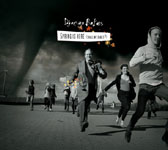 Django Bates: I actually had the basic idea for Spring Is Here back in 1995, at the Music Meetings festival in Holland, where I was performing with Delightful Precipice.
Django Bates: I actually had the basic idea for Spring Is Here back in 1995, at the Music Meetings festival in Holland, where I was performing with Delightful Precipice.The band that were on after us were from Cameroon. They were playing these incredible grooves where the detail at the top would stay the same while things at the ground of the music would switch and shift underneath, at the very foundation. It was remarkable and very exciting. When the switches occurred it was like the earth had moved below you and you were trying to work out which way was up and which way was down. We were all standing at the side of the stage with our jaws dropping, thinking, "What's going on?" And I thought, "Great. I've got the concept for the next season, spring." The plan was always to do Spring Is Here next.
I started writing the music in the months after that and gradually performed it with all sorts of people. Mainly with young bands. I did a youth project in Amiens, France; I did the European Jazz Youth Orchestra, which comes out of Scandinavia and is a great opportunity for young people to get on the road and learn about performance; there were several of these things where different young people got their hands on the music and made their mark on it. All of that fed into the writing. In the meantime though, I made some other albums and it never quite felt like the right time to document it.
AAJ: You had record label issues in the mid-1990s too, didn't you?
DB: Yes. All sorts of other things happened in the year or two after Winter Truce. One of these was that I lost the record deal with JMT, which became part of Verve and Polydor. Round about Winter Truce I performed at a music business conference in New York with Human Chain. I was so excited that I arranged "New York New York"—the infamous "derangement"—and it had the direct effect of losing us our deal with Polygram, because it was so totally not what they were into.
With the benefit of time, I'm quite pleased that happened, because although it was pretty hard, I had to take control of my own recordings. There were little things that happened along the way which helped me. In 1997, shortly after all that, I won the Jazzpar Prize, and this involved enough money to record Quiet Nights (Screwgun, 1998). It was a kind of accidental project which grew out of the Jazzpar—a small band project to contrast with the big, dense music I wrote for the Danish Radio Jazz Orchestra—Like Life (Storyville, 1998)—as part of the prize.
Finally, after I'd started at the Rhythmic Music Conservatory in 2005, it seemed like I was in the right place at the right time to turn it all into an album. Maybe another reason why I held back for so long was because I knew this would be the end of the four seasons cycle and I was quite enjoying being in the middle of it.
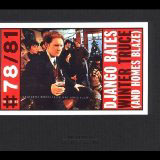 AAJ: So arriving at the RMC and starting StoRMChaser provided the final spur to record Spring Is Here?
AAJ: So arriving at the RMC and starting StoRMChaser provided the final spur to record Spring Is Here?DB: What I said at my interview was that if I got the job, if I got the chance, I'd form a band with the letters RMC in the name and take it round the world and put the RMC on the map. They looked at me for a moment and then it was kind of, "Go on then, do it."
I thought Spring Is Here would work with StoRMChaser, because I've worked a lot with young musicians, presenting them with what is in some ways complex music, and it's always been my experience that if you go at it with utter confidence and commitment it's successful. When you start, it's an enormous mountain to climb—sometimes we'd rehearse something for a week and then there'd be a gig where we could try it out—but the adrenalin and the excitement that is created by the process kick in and you're swept along with it.
AAJ: There's an irresistible groundswell of enthusiasm coming out of the band.
DB: There is. We meet every Friday and just keep pressing home, playing around, having fun. The RMC set-up means I can experiment. To have a band like this that I can play around with every Friday—it's a real luxury. It's something people like Duke Ellington had. Ellington had his band on a retainer and so he could always call them up when he needed to and say, "Could you come in and play this chord for me?"
It's a wonderful resource to have. I had it back in the days of Loose Tubes. We met up even when there was nothing new to play. It was like a social commitment, a very nice social commitment. It gives the opportunity to try out ideas—slow processes, rather than the usual thing where you write all the music and go into the studio and read it, nail it, get it down and that's that.
AAJ: Let's talk about some of the individual tracks. "The Right To Smile" articulates something at the core of your philosophy—the right to be free and enjoy life, the right to be yourself. The way you weave Beethoven's "Ode To Joy" and those national anthems into it is very effective.
DB: The piece is partly about nationalism and borders, the way border controls keep people within certain areas. I have quite direct experience of this in several ways. One is being in Denmark at the RMC. I'm there about half my time, so I have experience of being a "foreign worker." Of course, it's different to the situation many foreign workers find themselves in, because I'm regarded as coming from an "acceptable" country.
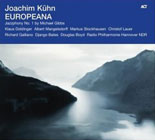 Then I have a friend who's English and his partner's Italian and they had a child in England. They've been living in England all their life together but the child can't get an English passport because they're not married. Little things like this make you realize what a paradoxical world we live in. The more you think about it, the stranger the world seems.
Then I have a friend who's English and his partner's Italian and they had a child in England. They've been living in England all their life together but the child can't get an English passport because they're not married. Little things like this make you realize what a paradoxical world we live in. The more you think about it, the stranger the world seems.So I had the idea of having some fun by throwing all these nationalistic songs together, to make something basically un-nationalistic out of the blend. When we perform "The Right To Smile" live we start with everyone singing their own personal anthem in their own language. There are quite a few different nationalities at RMC and doing this really destroys the whole idea of nationalism and patriotism because you get this chaos of sound. Then we go into the piece and have some fun with those songs. "Ode To Joy," that's such a special one, because it's the European anthem, and it's also such an incredible, joyful bit of music.
AAJ: As well as your experiences as a foreign worker, you travelled pretty widely as a child, didn't you?
DB: My parents led an unconventional lifestyle and we did a lot of travelling. There was one trip, to the Balkans, that I particularly remember and that I'm pretty sure has had some effect on my music.
My parents woke me up before it was daybreak, which is quite disorientating, and I remember I had to dress myself and I'd never done that before and I got everything in the wrong order. Then we got on a motorbike and sidecar combination, my sister and me in the sidecar and our parents on the bike, and off we went to what were then far flung parts of Europe like Romania and the former Yugoslavia.
It was an amazing journey. The only thing that I remember about Romania was that we got lost and it was dark and it was raining—I think it rained for most of that trip, and nothing was waterproof in those days, they hadn't invented Gortex. We were rescued by real Romanian Gypsies, and they gave me a wooden mug, carved out of single piece of wood, full of milk from a cow, still frothing and warm. I remember drinking that really clearly.
I'm sure there was lots of music around as well. I can't remember them singing and playing but I do know that when I hear that music today it strikes an immediate chord with me. And that's come through in everything I've wanted to write myself, the sound that I want to hear—that beautiful, real, coming from the earth sound.
 Django Bates (center) and members of StoRMChaser
Django Bates (center) and members of StoRMChaser AAJ: Another remarkable track is "Fire Brigade." It's extraordinarily catchy, a hit-in-waiting to set alongside "New York New York." How did that one come about?
DB: "Fire Brigade" was written right at the beginning of this music, directly inspired by that Cameroon experience. My idea was to write some pieces that were each very much in one key—which can give an impression of that very relaxed, happy feeling that we associate with African music. I like these little rules you can have to play around with. The other thing was these strange lengths of phrase running throughout the piece. There's an eleven beat phrase, and the track explores eleven in lots of ways, using different backing figures that are weaving in and out of the eleven beats. It's difficult to explain these things sometimes, but basically it's about having fun with music and numbers—which are closely linked.
"Sheep" was part of that early writing process too, that's why it goes into that long, looping thing with a bass line that's seventeen beats long. That's why the song is about sheep. They seem so similar but when you look at them closely you realize there are subtle differences.
There are lots of repeats, because when you repeat a musical phrase people feel comfortable with it. But if you have lots of things repeating, and they don't quite match up in length, you get this big kaleidoscope—it's like you're turning the wheel, seeing the same colored beads, but they're constantly reforming into different patterns.
It's a development of that Cameroon thing. I was asking myself what I was going to do with the songs to make them fascinating, to play around with the rhythm and the time aspect. In "Spring," for instance, during the first solo, everything is going along steadily and then the ground thing speeds up while everything else stays the same. That's exactly the excitement the Cameroon band had, that I wanted to get.
AAJ: The use of vocals on Spring Is Here is very striking. It seems you're increasingly interested in writing for voices. (Singer Josefine Lindstrand is featured throughout the album).
DB: Back in the early 1990s I did a couple of records with a Norwegian singer, Sidsel Endresen. Doing them opened my ears to the possibilities of using a singer and words. It was almost like having an actor on stage, telling a story, rather than a singer in the traditional sense. Previously, I'd been put off the idea of jazz and singing together because there was certain style of doing that—very over the top, lots of vibrato—while I prefer something quite different, more natural.
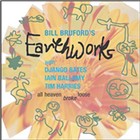 Then a few years later, when I did the Jazzpar, and they asked me to put together a contrasting project, the first thing I saw when I went to gigs in Copenhagen was a student jam session. There was this girl who just sang a standard beautifully and then sat down—and all these males improvised for about an hour, all taking turns to solo kind of competitively, while she sat there quietly, like in a trance. Then when they finished she just got up and sang the song again. Something about that amused me and I was impressed by it.
Then a few years later, when I did the Jazzpar, and they asked me to put together a contrasting project, the first thing I saw when I went to gigs in Copenhagen was a student jam session. There was this girl who just sang a standard beautifully and then sat down—and all these males improvised for about an hour, all taking turns to solo kind of competitively, while she sat there quietly, like in a trance. Then when they finished she just got up and sang the song again. Something about that amused me and I was impressed by it.After that, I got more interested in having the power of the human voice in my music. Because people had always said, "Yeah, I like your stuff, but it's kind of complicated, anybody who isn't a musician isn't going to be able to bear to listen to it." Maybe I'm exaggerating, but I got the impression that what I did was perceived as being quite muso orientated, and I found that a singer opened it out to more people.
AAJ: Does having a vocalist change the music?
DB: It doesn't have to. I haven't changed the music, I still have the same aims, the same things I like to play around with, but if you include a singer in that—without bringing everything else down to a more simplistic level—it opens it out.
Josefine Cronholm on Quiet Nights has such a beautiful, rich sounding voice. We toured that project for a while, we even came to England with it, and then she took a break to start a family. I was just starting a European youth jazz orchestra tour and I received some demo tapes and one of them was from Josefine Lindstrand—just her voice, no piano even. It was special enough, idiosyncratic and also Swedish—and her name was also Josefine—and so I rang her and said, "Can you do a gig in Holland?" She said, "But we haven't even rehearsed." And I said, "It's an emergency."
So she said OK and came along and she was just so relaxed and professional and in tune with everything. She's a quite different singer to Josefine Cronholm, more lively and right on the beat compared to the very relaxed thing we'd done on Quiet Nights with standards and ballads.
AAJ: Two of the tracks on Spring Is Here are performed by the RMC's choir, Som En Sten.
DB: Well, when I came to put the tracks together for the album I could see all this big, loud music and I just thought it would be great to break it up with some quiet, beautiful music. That sort of thing is possible to do quite quickly at RMC.
Som En Sten means "like a stone." It someone asks you if you've slept well, in Denmark you don't say, "like a log," you say, "som en sten." It's quite a good name for a choir, because a choir can be so still, and so beautiful, and that's harder to do using instruments other than the human voice and still have that power in the music.
 AAJ: A couple of minutes ago you said that using a singer hasn't changed your music, that you still have the same aims. What are those aims?
AAJ: A couple of minutes ago you said that using a singer hasn't changed your music, that you still have the same aims. What are those aims?DB: When I start writing a piece of music, there are two main things. One is myself and what I want to hear; the other is the listeners and what's going to be the effect on them of every part of the composition. So right from the beginning I'm thinking of the structure of the piece and how it's going to effect people. My instinct nearly always is to try and surprise them, not necessarily in a stupid or funny or shocking way, sometimes in a very subtle way—so that they find themselves taken to another place.
AAJ: You're clearly not just trying to make a living out of your music. It feels like there's something bigger going on.
DB: Well, if I was just trying to make a living, I would probably be better off not doing most of what I am doing. I suppose, if it doesn't sound too bigheaded or pompous to say so...(Bates pauses, considering whether to continue)...what I'm trying to do, ultimately, is change peoples' heads through music.
That's the broad answer. Within that is all the detail of what I want to write—trying to create something that is multi-dimensional and works in different ways for different people, and where there's lots going on from whatever angle you listen to music. My experience of listening to many big band albums is that it can be frustrating, because it's very difficult to record the music so that you can clearly and distinctly hear everything you want to be heard. You may find you've written something that is impossibly rich. You mentioned cooking earlier. With an incredible piece of cooking, you can taste all the ingredients, you can sit there and list them out, and they all blend together. It's fascinating to record this music and make all those decisions about what you want to hear.
AAJ: You've done that brilliantly. The music on Spring Is Here is very rich and dense, both in the rhythms and the harmonies. There's so much going on. Yet the production is so clear that the listener can zoom in on the smallest details.
DB: That's certainly the idea. It was produced with Andrew Murdock, who recorded Winter Truce. He's an American character who has had enormous hits with a US rock band called Godsmack. It's not the sort of thing I listen to myself, but Andrew is working in that side of the business almost accidentally—he's very keen to do what he might describe as more artistic projects, which is why I'm able to get hold of him for my stuff.
He did the live sound for Bill Bruford when I was in Earthworks. He had a good vibe and worked in a very different style to the way most English engineers would work. Like in England, if I'd say, "Can you turn that thing there up?" (Bates mimes sliding fader up), they'd nudge it up by maybe a millimeter—whereas if I said that to Andrew, he'd go whack and push it up a couple of inches. Because he doesn't want to be asked again!
That's what I wanted. With all my delicate detail, I wanted someone to come in and go "yeah!" and crank it up, smash it out of the speakers. He also did You Live And Learn (Lost Marble, 2004), he worked fantastically on that one. When it came to Spring Is Here I told him I didn't want it to sound like a traditional big band album, very brassy, horn heavy, where there isn't much production going on, where everything just sits in the same place and there's no reverb or effects.
AAJ: Is your work at the RMC going to continue for a while?

DB: The contract's for five years, and I've done three. I need to have a meeting and find out what's planned beyond that. It would be sensible to look a couple of years ahead. As time goes on I realize it's fantastic to have the job, where at the same time I have the freedom to carry on with other music and other bands. It would have been a mistake if I'd just gone into a room and come out five years later and said, "42, you've got to play everything in 42!"
There are new projects that I can't wait to get started on. It's quite easy to record things at the RMC, with their studios and good pianos and the resources of great musicians who are eager to experiment. So there are several things I want to do. Time is the challenge, finding the time.
You've observed that it's often several years before I record things, and that usually occurs when I can't bear to hear them anymore without them being recorded. But I would like to speed up my output, to record a few more things in the next couple of years. For the first time, since my very first gigs, I'm playing with a piano trio. I'd moved away from that as fast as I could because it seemed such a cliché. But now, having had time to be away from it and to reflect, it's been really good fun to just walk into a room and not have to carry any leads or use any electricity, but just to sit down at the piano and play music just for a piano trio.
But I shouldn't go on about that too much. It's best to do things before you talk about them.
Selected Discography
Django Bates StoRMChaser, Spring Is Here (Shall We Dance?) (Lost Marble, 2008)
Django Bates Human Chain, Josefine Lindstrand & The Smith Quartet, You Live And Learn (Apparently) (Lost Marble, 2004)
Django Bates Human Chain & Josefine Cronholm, Quiet Nights (Screwgun, 1998)
Django Bates Human Chain & The Danish Radio Jazz Orchestra, Like Life (Storyville, 1998)
Django Bates Human Chain & The London Sinfonia, Good Evening...Here Is The News (Decca Argo, 1996)
Joachim Kuhn, Europeana (ACT, 1995)
Django Bates Human Chain & Delightful Precipice, Winter Truce (And Homes Blaze) (Winter & Winter, 1995)
Django Bates, Autumn Fire (And Green Shoots) (Winter & Winter, 1994)
Tim Berne, Nice View (Winter & Winter, 1994)
Django Bates Human Chain & Delightful Precipice, Summer Fruits (And Unrest) (Winter & Winter, 1993)
Sidsel Endresen, Exile (ECM, 1994)
Bill Bruford, Stamping Ground (Summerfold, 1992)
Bill Bruford, All Heaven Broke Loose (Summerfold, 1991)
Django Bates Powder Room Collapse Orchestra, Music For The Third Policeman (Ah-Um, 1990)
Sidsel Endresen, So I Write (ECM, 1990)
Django Bates & Human Chain, Cashin' In (EEG, 1988)
Human Chain, Human Chain (Ah-Um, 1986)
Loose Tubes, Delightful Precipice (Loose Tubes, 1986)
Loose Tubes, Loose Tubes (Loose Tubes, 1985)
Photo Credits
Top Photo: Paolo Soriani
All Other Photos: Martin Munch
Tags
PREVIOUS / NEXT
Support All About Jazz
 All About Jazz has been a pillar of jazz since 1995, championing it as an art form and, more importantly, supporting the musicians who make it. Our enduring commitment has made "AAJ" one of the most culturally important websites of its kind, read by hundreds of thousands of fans, musicians and industry figures every month.
All About Jazz has been a pillar of jazz since 1995, championing it as an art form and, more importantly, supporting the musicians who make it. Our enduring commitment has made "AAJ" one of the most culturally important websites of its kind, read by hundreds of thousands of fans, musicians and industry figures every month.



